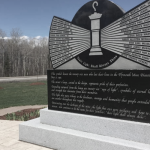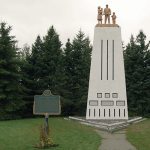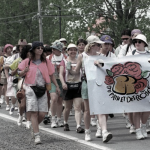The “On To Ottawa Trek” was a worker protest against unfair treatment and government austerity that captured public support, contributed to the defeat of the Conservative federal government of R.B. Bennett later that year, and paved the way to the establishment of a national unemployment insurance plan.
In the 1930s, “The Great Depression” had crippled the Canadian economy and resulted in massive unemployment. In response, the Federal Government created “relief camps” where thousands of men lived and worked at a rate of twenty cents per day.
[[{“fid”:”1292″,”view_mode”:”default”,”fields”:{“format”:”default”,”field_file_image_alt_text[und][0][value]”:”Work camp protest”,”field_file_image_title_text[und][0][value]”:”Work camp protest”},”type”:”media”,”field_deltas”:{“2”:{“format”:”default”,”field_file_image_alt_text[und][0][value]”:”Work camp protest”,”field_file_image_title_text[und][0][value]”:”Work camp protest”}},”link_text”:null,”attributes”:{“alt”:”Work camp protest”,”title”:”Work camp protest”,”style”:”font-size: 13.008px;”,”class”:”media-element file-default”,”data-delta”:”2″}}]]
By 1935, people had had enough. In April that year, following a two-month protest in Vancouver over the dismal and unfair working conditions in the camps, more than a thousand unemployed workers boarded – or rather jumped on top of – railway box cars in what became to be known as the “On‑to‑Ottawa Trek.” Their goal: to meet as a group with the Conservative government of the day and demand better conditions and a fairer way to address unemployment.
[[{“fid”:”1296″,”view_mode”:”default”,”fields”:{“format”:”default”,”field_file_image_alt_text[und][0][value]”:false,”field_file_image_title_text[und][0][value]”:false},”type”:”media”,”field_deltas”:{“1”:{“format”:”default”,”field_file_image_alt_text[und][0][value]”:false,”field_file_image_title_text[und][0][value]”:false}},”link_text”:null,”attributes”:{“class”:”media-element file-default”,”data-delta”:”1″}}]]
The Prime Minister eventually agreed to meet, but only with a handful of representatives, not all of the workers. While those representatives travelled to Ottawa, the hundreds of other trekkers “waited” in Regina (they were actually being held in place by the RCMP).
The meeting went badly, with the Prime Minister accusing the trekkers of being radicals leading an insurrection. When the workers’ representatives returned to Regina with news of their meeting, nearly 2000 people joined 300 trekkers as a show of protest and solidarity for workers’ rights.
The police charged the crowd, setting off hours of hand-to-hand fighting throughout the city’s centre. People fought back with sticks and stones while police used tear gas and fired bullets above and into groups of people.
Damage to property was considerable and personal injuries were many; one trekker and a plainclothed policeman died while hundreds of injured local residents and trekkers were taken to hospitals or private homes. The police proceeded to arrest those in hospital, along with over 100 others.
The police claimed 39 injuries in addition to the dead police officer, but denied that any protesters had been killed in the melee. Hospital records were subsequently altered to conceal the actual cause of death.
Later that year, in reaction to public support for a better deal for the unemployed, the federal government passed the Employment and Social Insurance Act and the country’s first national unemployment plan.
Eventually, the government was defeated, and its hastily-crafted law struck down in the courts. But, the bold attempt at reform paved the way for the establishment of a national unemployment insurance program under the new government, led by W.L.M King, in 1940.


